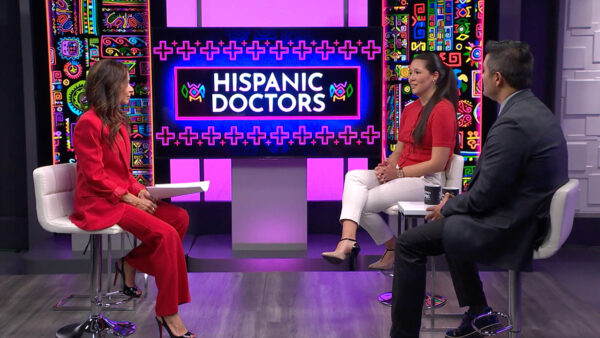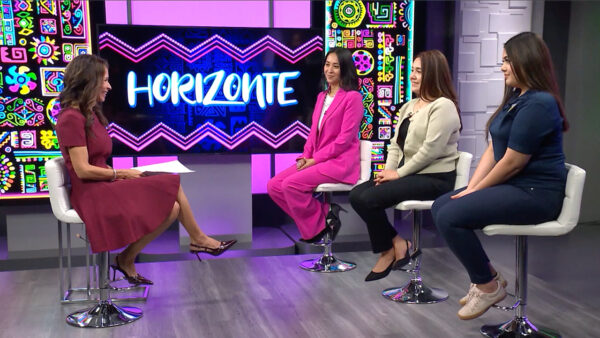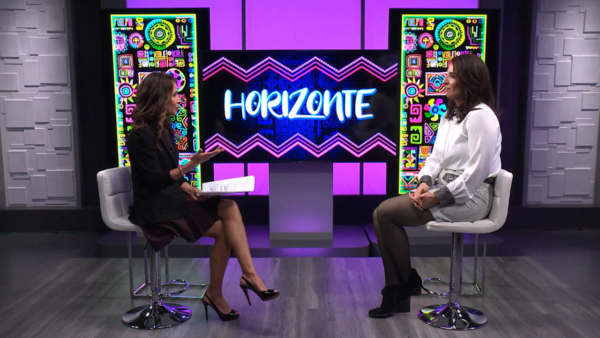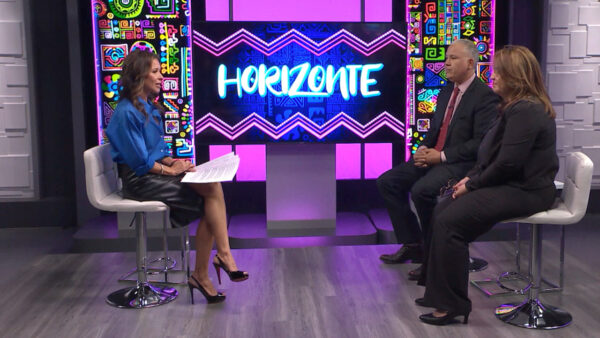What does the future hold for day labor centers? Governor Napolitano recently signed legislation that prohibits taxpayer money from being used to pay for such centers. How effective have they been? How does the new law prohibiting the use of taxpayer funding impact these centers?
>> José Cárdenas:
Tonight on "Horizonte," from the classroom to the board room, from the fields to the factories, Latinos are increasing in number and purchasing power. A look at the latest demographic information on Hispanics.
>>> Plus, day labor centers are so controversial many local cities have backed away from starting one. Now, a new state law could further limit them. We'll look at the future of day labor centers.
>>> Also tonight, local city councils may represent sizable Latino populations, but few council members are themselves Latino. We'll tell you what one organization is doing to change that. Next on "Horizonte."
>> Announcer:
Funding for "Horizonte" is provided by Bank of America, who applauds those who strive for excellence. Bank of America, higher standards. And by SRP. Announcer: SRP's business is water and power, but our dedication to the community doesn't stop there. SRP, delivering more than power.
>>José Cárdenas:
Good evening, I'm José Cárdenas. A new study by the Pew Hispanic Center estimates that Arizona has more than half a million unauthorized immigrants living here. The information is based on the March 2004 current population survey conducted by the U.S. Bureau of Labor Statistics and the census bureau. The Pew Hispanic Center estimates that the total number of undocumented immigrants in the United States at 10.3 million at the time of the survey. Arizona ranks fifth in total number of such immigrants behind California, Texas, Florida and New York. The Pew Hispanic Center also notes that 4.7 million kids are the children of undocumented immigrants. The study estimates that the undocumented population includes 1.5 million kids and another 3.2 million kids born in the United States. As far as where these immigrants come from, the Pew Hispanic Center estimates 57% of the undocumented population is from Mexico, 24% from Latin America, 9% from Asia, 6% from Europe and Canada and 4% from Africa and other countries.
>>José Cárdenas:
The report comes on the heels of new census data that show one in every two new Americans is Hispanic. The Census Bureau says that of the 12 million new Americans since the 2000 census, half, some 6 million, are Latino. Immigration and high birth rate are two major factors. As of July 1st, 2004, the Latino population in the U.S. totalled more than 41 million people. Joining me to talk about the growing Hispanic population is Earl de Berge, director of the Behavior Research Center which specializes in following the Hispanic market. Earl, it's good to have you back on "Horizonte."
>> Earl de Berge:
Good to be here.
>>José Cárdenas:
I know the pew Hispanic report just came out. It was in the paper. You haven't had a chance to study it in detail, but anything in there that surprised you?
>> Earl de Berge:
Pew is a wonderful contribution. They have a knowledge of the Hispanic market second to none in the country. The estimates of the illegal legal population in Arizona is probably high and may even be significantly high. Our estimates are that both nationally and certainly in Arizona, which has a much longer history of Latinos in this state, many of whom are native and have roots running back, four, five, six generations, that the population that is native born or naturalized is probably in the neighborhood of 65 to 70%. So half a million out of a million would be an overestimate by my thinking.
>>José Cárdenas:
What about our relative ranking with other states? The new report has us above New Jersey and Illinois.
>> Earl de Berge:
In terms Hispanic population?
>>José Cárdenas:
Illegal immigrants?
>> Earl de Berge:
I don't know the answer to that. I wouldn't be surprised. The population of immigrants coming into this country are dispersing all over the country. That's one of the more emerging patterns. Going to places where there is jobs. They are going to major cities where there is employment opportunity and where they can find a place to make a living, because they are here to make a living.
>>José Cárdenas:
One of the other things the report noted is that while you have large numbers of Hispanics in the states you would expect that border Mexico, you've got now growing numbers in North Carolina, other states such as that.
>> Earl de Berge:
Well some of the really big areas include Minnesota, Chicago, Georgia, some of the southern states. Yeah, the populations are dispersing. That is the pattern. Generally, the eastern states are seeing people coming from eastern Mexico and the western states are seeing people coming from western Mexico.
>>José Cárdenas:
Let's talk about your research. I want to get to some specifics, but let's begin with kind of an overall thumbnail sketch of what I think you called "the new Latino" at least in terms of the old stereotypes.
>> Earl de Berge:
Well, it's really interesting, this immigration debate is occurring as it is, because it's coming right in the face of the emergence of a really dynamic and upward mobile middle class that's Hispanic. We're beginning to define more carefully?
>>José Cárdenas:
We're talking about Arizona?
>> Earl de Berge:
We're talking about Arizona and nationally. The upward mobility of the Latino population in this state for certain is very, very remarkable, and they are becoming a huge part of the consumer market, he retail market, the real estate market, almost anything you want to define. And again, I urge people when they think about -- one of the unfortunate parts of what's happening in the debate in Arizona now is it is focusing only on the immigration issue and not focusing on the entire population, so you have a sense of putting it in some kind of perspective. This population, the Latino in are Arizona, is really upward and mobile and moving fast. The percent of increase in white-collar occupations is rising at the rate of a percent of year.
The absorption of the English language and the desire to learn the English language amongst even new populations is fantastic. Let me just read you a number on that if I could. We took a look at use of English language by generation, if you will in this country. Basically by the time -- in first generation we have 61% of Latinos who are first generation here are using English. With 50% of that group using it equally. By the time you get to second generation, it jumps up to 96%. By the time you are third generation it is 100%. It really raises questions as to whether or not this English only move is a red herring because the desire on the part of Latinos to master the English language as because they see it as the vehicle to success in the economic system and education system and occupation world of the United States. It doesn't need any producting. They are very motivated.
>>José Cárdenas:
Are people misleading people are their underlying assumptions are wrong?
>> Earl de Berge:
I think the underlying assumptions are wrong. The notion that Mexicans are coming to the United States for the purpose of changing our culture is really a completely backward thought. They are coming here because they are dissatisfied with something where they are and they are trying to move into a new area and become a part of it. It doesn't mean they don't want to hang on to their culture the same as an eye rash man will do. Is there inconsistency between your numbers and the Hispanic stations are the major leaders in the markets.
>> There are two Hispanic languages stations on television. 80% of Latinos in Arizona speak English. 65% speak Spanish. The fact that they like to pick and choose amongst a broader array of radio stations and television stations is a luxury that they have that people who aren't bilingual don't have. But there are huge percentages that are listening to rap stations that are listening to Rock & Roll, classical music and so on.
>>José Cárdenas:
Some of your stereotypes that your research refutes are those held by Latinos and non-Latinas. Especially with regard to Latinas.
>> Earl de Berge:
That is the single most profound change. The emergence of Latinas in the work force. We estimate now -- we just did a study on Latinas in the work force. We've got a 40% part of that sample are Latinas. In addition, we've been asking separate questions on the views that Latina heads of household have about the importance for getting ahead in America, of the woman in the household having a full-time job. These are majority views that women need to be in the work force that a female head of household needs to be employed in a full-time job. These are profound impacts on a cultural group that traditionally had the woman at home taking care of the family and doing the family business. She's now out in the workplace. She is going to be forced to or is seeking to learn more language. Is making friends outside of the immediate neighborhood and learning skills and whatnot that are more prevalent in the general so side than they are in the Latino society. And raising the income of the family. You go from one person household earner to two. That has a tremendous impact. It has all kinds of -- they are starting their families later. They are having fewer children. All of those things are occurring today in this dynamic in the Latino community. It's almost invisible because of the focus on that portion of the population that's illegal.
I think latinos have the same problems, the permanent population has the same problems trying to wrestle with and understand in their own mind how they feel about this issue as non-Hispanics do. But by and large, this population is so much larger and more dynamic and upward mobile than it is being painted. It's really a shame. It doesn't give us an opportunity to enjoy and understand where this population is going. Earl, we'll have to end it there. We'll have you back to further discuss these numbers. Thank for joining "Horizonte."
>>Earl de Berge:
Thank you.
>>José Cárdenas:
One of the last bills Governor Napolitano signed into law this year was a requirement that no state or local taxpayer money be used to fund day labor centers. There is no question it is a controversial issue for local governments. The City of Mesa began looking at the idea of a Day Labor Center five years ago, but abandoned it. The City of Phoenix built a Day Labor Center two years ago in northeast Phoenix, although taxpayer money was used to buy the land and build the facility, it is operated with funds from nonprofit community groups. It was renewed last winter, despite vocal opposition. There are two other day labor centers run by churches, one in Cave Creek, another in Chandler. Paul Atkinson looks at the latter to see how that community's Day Labor Center has fared since opening two years ago.
>> Paul Atkinson:
It's a familiar scene in various parts of the valley, immigrants standing along the street waiting for someone to drive by and hire them for day labor. For Chandler, the scenario is a touchy one. Many of these immigrants don't cause problems, but some do. Immigrants harassing teenage girls on their way too and from school led the city to target illegal immigrants in a roundup back in 1997. About 500 suspected illegal immigrants were arrested with the help of immigration, but in the process, dozens of Americans citizens or legal immigrants felt harassed by police, which caused major headlines and headaches for the city. It's been eight years since the roundup and immigrants loitering along the streets is still a concern, only this time a more practical solution was put in place. Tucked away off Arizona Avenue, south of downtown Chander is a day labor center. It's not run by the city, but by a church. Pastor Jose Gonzalez overseas it.
>>Jose Gonzales:
The center is here to serve the worker. It was specifically built to serve the workers. We provide all of the services to keep them healthy and safe. We give them water, bathrooms, a place to stay in the shade out of the hot sun. We give them breakfast every single day. All of these services are provided free of charge. It isn't cost them anything. We don't ask for anything. We provide all of these services for the workers.
>> Paul Atkinson:
At 10:30 in the morning, there are only three men waiting for jobs. Gonzalez says 25 to 30 men show up daily at 5:00 in the morning and most are hired by 7 a.m. The Jose Gonzales s and the person who hires them are asked to sign contracts, stipulating the kind of work, the hours and how much they will be paid.
>>Jose Gonzales:
This is good for the community, a good service for the workers, because they will also have the security that they will be paid a fair wage. You talk to the people on street, you will hear many of them say that they weren't paid enough, or that they just weren't even paid. Some of the workers had said they get paid in little tight rolls of money and on the outside it will have a $5 or $10 bill and when they open it up, there are only $1 bills on the inside where there should have been five or ten dollar bills.
>>: Paul Atkinson:
Rosales says hiring a laborer from the center is safer. Many Jose Gonzales s aren't here for long.
>> Jose Gonzales :
For Chandler, I think it's basically a city that people come through. Normally people don't complain about illegal immigrants because the majority are going to other states. They don't stay permanently in Chandler. The ones that stay here are few.
>> Paul Atkinson:
There is no doubt that Day Labor Center fills a role in Chandler. Several nearby business owners "Horizon" talked with said it hasn't talked with the number of immigrants waiting for work along the streets, but they also haven't had as many problems with them.
>>José Cárdenas:
Joining me to talk about day labor centers are Jose Cortez of Chicanos por la Causa. They help run the Phoenix Day Labor Center. Also here is Pat Gilbert. Thank you for joining us on "Horizonte." Jose, first tell me about Chicanos por la Causa and elaborate what we heard about on the segment.
>> Jose Cortez:
We responded to a call because along with three other nonprofit organizations, which is friendly house, via Del Sol. There were individuals congregating in the north Phoenix area in driveways, along private driveways which was creating a problem, a safety hazard. The City of Phoenix studied the situation, and realized that something had to be done. They had to address the issue. Of those four nonprofit organizations came together, collaborated --
>>José Cárdenas:
at the request of the city?
>> Jose Cortez:
At the request of the city, collaborated with the city to try to find a viable solution to deal with this problem. And the idea was to start a center where these individuals could congress gate safely without having to cause any problems in the community.
>>José Cárdenas:
And I want to talk about what kind of success the center has had, but before we do that, let me ask, Pat, tell us a little bit about your organization and what it's involvement has been on this issue?
>> Pat Gilbert:
Bake community action network is basic needs grassroots, anti-poverty nonprofit, and we're located about a quarter mile from the epicenters of sort of the day labor situation in Mesa, Broadway and Mesa Drive. Similar to CPLC and the other three nonprofits in Phoenix. Mesa Community Action Network responded to the report provided to the city council in Mesa by the day labor taskforce recommending that a Day Labor Center be established to address some of the community issues and problems associated with lots of men congress gating on the streets. Our agency basically provides everything from emergency food boxes to more sophisticated rent and utility services, and we also operate the East Valley men's center, a program for homeless men helping them get back to work.
>>José Cárdenas:
Now, you guys started on this, or the City of Mesa did on this, about five years ago. There's no Day Labor Center, why?
>> Pat Gilbert:
Well, during that time, as you know, and much of your audience knows, proposition 200 passed, and the controversy --
>>José Cárdenas
: that was just last year.
>> Pat Gilbert:
It took Mesa Community Action Network a couple of years to formulate a plan and find a piece of property, which was all accomplished, but the issue has really created an acrimony and division in the community and it's been in the judgment of our organization, my bosses, the board of directors, that it is not the right time for us to push the issue, and we're not sure of an outcome of a city council vote, and based on that, we've actually tabled our application to the city for a use permit.
>>José Cárdenas:
So there is nothing in Prop 200 that would prohibit this, it's just that you decided the environment wasn't right to push it?
>> Pat Gilbert:
Correct.
>>José Cárdenas:
Jose, only two cities, not counting the two churches that run organizations in Chandler and Cave Creek have done this. Why? Why haven't there been more day labor centers? It's a legitimate problem you are dealing with.
>> Jose Cortez:
Well, there are more day labor centers, not here in Arizona that I know of, but I know nationwide, there are day labor centers that are addressing the same need. Again, there are individuals that are looking for work. There's work in certain pockets of the city that are plentiful, and regardless of what happens, these individuals are still going to continue looking for work.
>>José Cárdenas:
Now, one of the statistics that was mentioned at the recent forum on day labor centers was that at the location in north Phoenix, crime went down 40%. You would think that would be something that would generate more enthusiasm in support of day labor centers. Why hasn't it?
>> Jose Cortez:
Well, the crime rate, obviously has gone down, and you know, in addition to that, there has also been the center last become a well established center, that is providing opportunities for work, for individuals. Again, the anti-immigrant sentiment is something that is causing a lot of chilling effects within the community, and I think that that in itself is causing a lot of individuals to kind of pull away from it.
>>José Cárdenas:
Pat, you attended the recent forum, six cities, their human relations councils put it on on day labor. Anything about the forum or comments that were made that struck you as particularly important?
>> Pat Gilbert:
Well, I think there was an attorney with the national day labor organizing network, make the point at the forum that Arizona's initiatives legislatively are contrary to a national trend to try and manage what really becomes a local problem, including enforcement issues, of helping police departments determine where crime occurs and why it occurs, reducing the negative public consequences of having lots of men and sometimes women standing around on street corners that really from Seattle south across California to Maryland, across the nation, communities are opening day labor centers as rational public policy alternatives.
>>José Cárdenas:
And these all taxpayer funded?
>> Pat Gilbert:
Yes, by and large, these communities are investing in labor centers, like many of the human and social service programs that have grown up around other issues, whether it's hunger or otherwise. And that was one of the important points, I think, that was made at the forum, that our governors and policy tendencies are not in that direction.
>>José Cárdenas:
And specifically, the new legislation that prohibits the use of taxpayer funds for day labor centers or that wouldn't allow cities and towns to do it. But is there any practical consequence to that? Were there any cities -- we just talked about Mesa, they are not going to do it in the near future, and Phoenix is now not taxpayer funded, so as a practical matter, does it make any difference?
>> Pat Gilbert:
Well, I think in some respects, yes, but in the current environment, likely, no. Because I don't believe there are communities in the state that would be ready to address the issue and then likewise fund it with their city general revenue funds. It's enough of a political issue that taking the next step for the investment of taxpayer dollars is really, I think, highly unlikely.
>>José Cárdenas:
We've only got a minute left. Let me ask you, Jose. What's going be the role of nonprofits in light of this atmosphere that we have here in the State of Arizona?
>> Jose Cortez:
Well, nonprofits have over the years have dealt with a lot of these social issues; they have a lot of experience. They -- I think that we are willing to collaborate with anyone that is willing to address this issue. Obviously it's an issue that has to be addressed as I mentioned. It's not going to go away. So, again, working with anyone that is willing to work with us in order to solve this problem.
>>José Cárdenas:
We're going to have to leave it at that. Jose, thank you for joining us on "Horizonte." Pat, thanks for being here.
>> Pat Gilbert:
Thank you.
>>José Cárdenas:
Running for elected office can be a frightening experience, even for the most passionate of advocates. That's because there are numerous laws and deadlines to learn about, and then there's the campaign which can be time consuming and costly. A series of workshops next week sponsored by the Mesa Association of Hispanic Citizens will walk people through the process of what it takes to run for office. Joining me to talk about it is Deanna Villanueva Saucedo of the Mesa Association of Hispanic Citizens. Thank you for joining us on "Horizonte."
>> Deanna Villanueva Saucedo:
Thanks.
>>José Cárdenas:
What's the purpose of this workshop?
>> Deanna Villanueva Saucedo:
The purpose is a nuts and bolts training session for those who might be willing to run for office. So this really will provide some nuts and bolts information. We have someone there from the Mesa city clerk's office to talk about filing deadlines. We will have a CPA to talk about financing. We will have an elected official to talk about what it is to be a candidate, the realities of being a candidate, political consultant and also several columnists from "The Arizona Republic" to talk about working with the media. It's very hands-on training for those interested in running for office.
>>José Cárdenas:
Mesa has a 25% Hispanic population.
>> Deanna Villanueva Saucedo:
Yes, correct. Mesa only went to a counsel district system a few years ago, two election cycles ago, and I think now people are really beginning to realize among the Latino community that we have a voice and we have an opportunity to put an elected official in office. We had a Latina running for mayor the last City of Mesa mayoral election who garnered quite a number of votes. We also had one of our community activists a Latina running for school board.
>>José Cárdenas:
Both of them were fairly prominent in the community both within and without the lot tone know community.
>> Deanna Villanueva Saucedo:
Uh-huh.
>>José Cárdenas:
Both of them soundly defeated, though.
>> Deanna Villanueva Saucedo:
Yes, and unfortunately, our community is starting to learn how to equip someone to run for election, how to support someone running for election, and I think it's a learning process.
>>José Cárdenas:
Do you think any of the stuff that you guys are focusing on these workshops would have helped either one of them?
>> Deanna Villanueva Saucedo:
Undoubtedly. One of them has been one of the initiating members work ongoing this project to bring the candidate workshop together, and she often will comment on lessons learned and has now mentored others who are interested in running for political office. Again, that education is the key. Educating our community, educating prospective candidates.
>>José Cárdenas:
The workshops are open to anybody; you don't have to be Latina or be from Mesa, as I understand it.
>> Deanna Villanueva Saucedo:
That is correct, entirely open to the public.
>>José Cárdenas:
What do you hope to accomplish in terms of changing the makeup of politics in Arizona?
>> Deanna Villanueva Saucedo:
I think part of the success of this project has been that it's even gotten off the ground. If you look at sponsors to put this together, it includes the Mesa Association of Hispanic Citizens, which was the initiating organization. We have an board Mesa Community College through its center for public policy, Mesa leadership training and development alumni, the Martin Luther junior celebration committee. So the fact that we have so many organizations bringing their resources and contacts to the table to really create this type of events, which has not happened before, I think in and of itself is a success. If we can properly equip a potential candidate to effectively run for office that would be even better.
>>José Cárdenas:
We wish you the best of luck at the forums. We've got a little bit of information we'll share with our audience as to how to attend. Thank you for joining us on "Horizonte."
>>José Cárdenas:
If you'd like to attend one of the candidate training workshops, they take place in Mesa next week from 6:30 to 8:00 p.m., Tuesday at the Maricopa County community college, Red Mountain Campus; Wednesday at the Mesa Community College downtown campus; and Thursday at the Mesa Community College Williams campus.
>>José Cárdenas:
If you'd like more information on the workshops, please visit our web site at www.azpbs.org and click on "Horizonte." Just click on the candidate workshop flyer at the bottom of the page. Thank you for joining us for this edition of "Horizonte." I'm José Cárdenas. Good night.
Jose Cortez: Chicanos por la Causa, which helps run the Phoenix Day Labor Center;
























